- Choosing the Wrong Location
- Neglecting Soil Preparation
- Overwatering or Underwatering
- Overwatering
- Underwatering
- The right balance
- Ignoring Crop Rotation
- Benefits of Crop Rotation:
- Tips for Crop Rotation:
- Conclusion
- Planting Too Close Together
- Failing to Provide Proper Support
- 1. Staking
- 2. Trellising
- 3. Cage structures
- 4. Netting
- 5. Modular systems
- Not Pruning or Thinning Plants
- 1. Enhanced air circulation
- 2. Improved sunlight penetration
- 3. Preventing competition for nutrients
- 4. Minimizing pest problems
- Ignoring Pest and Disease Management
- Common mistakes to avoid:
- Skipping Regular Weeding
- Harvesting Too Late or Too Early
- “Question-Answer”
- What are some common mistakes to avoid when growing vegetables?
- How often should I water my vegetable plants?
- What are the consequences of overwatering vegetables?
- How far apart should I plant my vegetable seeds?
- Can I grow vegetables without direct sunlight?
- Should I use fertilizer when growing vegetables?
- How can I protect my vegetable plants from pests?
- “Video” #1 Mistake when growing Watermelon !
Gardening is a rewarding and fulfilling hobby, but it can also be quite challenging. Whether you’re a beginner or an experienced gardener, it’s important to avoid common mistakes that can hinder the growth and success of your vegetable garden. In this article, we will discuss ten common mistakes that many gardeners make and provide tips on how to avoid them.
1. Overwatering
One of the most common mistakes that gardeners make is overwatering their plants. While plants need water to grow, too much water can lead to root rot and other diseases. It’s important to water your plants judiciously, taking into account the specific needs of each plant and the weather conditions.
2. Planting too close together
Another mistake to avoid is planting your vegetables too close together. Plants need space to grow and proper air circulation. If they are planted too closely, they may compete for resources and be more susceptible to diseases and pests. It’s essential to research the spacing requirements for each vegetable and follow the guidelines accordingly.
3. Neglecting soil preparation
Good soil is the foundation for a successful vegetable garden. Neglecting soil preparation can lead to poor nutrient availability and drainage, hindering the growth of your plants. To avoid this mistake, make sure to amend your soil with organic matter, such as compost or manure, and test its pH and fertility levels.
4. Failing to rotate crops
Planting the same vegetables in the same spot year after year can deplete the soil of nutrients and lead to soilborne diseases and pests. Crop rotation is an essential practice that helps maintain soil health and reduce the risk of plant issues. Make sure to rotate your crops annually and follow a proper crop rotation plan.
5. Ignoring pest control
Pests can wreak havoc on your vegetable garden if left unchecked. Ignoring pest control can result in damaged plants and reduced yields. It’s important to identify common pests in your area, implement preventative measures, and take action if pests are present. This can include using organic insecticides, companion planting, and regularly inspecting your plants for signs of pest damage.
6. Not providing support for vining vegetables
Many vegetables, such as tomatoes and cucumbers, are vining plants that require support for optimal growth. Not providing support can lead to tangled and damaged plants, as well as reduced airflow and increased disease risk. Make sure to provide adequate support, such as stakes, cages, or trellises, for vining vegetables to ensure healthy growth.
7. Forgetting about weed control
Weeds compete with your vegetable plants for nutrients, water, and sunlight. Forgetting about weed control can reduce the overall health and productivity of your garden. Implementing effective weed control measures, such as mulching and regular weeding, can help keep weeds at bay and give your vegetables the best chance to thrive.
8. Failing to adjust planting and care practices
Growing vegetables is not a one-size-fits-all endeavor. Different plants have different needs and requirements. Failing to adjust your planting and care practices accordingly can lead to poor growth and yield. It’s essential to research each vegetable’s specific requirements for planting depth, spacing, water, and fertilization, and provide the necessary care throughout the growing season.
9. Not harvesting in a timely manner
Harvesting your vegetables at the right time is crucial for flavor, texture, and overall plant health. Not harvesting in a timely manner can result in overripe or damaged produce, reducing its quality. It’s important to regularly check your plants for mature fruits or vegetables and harvest them promptly to enjoy the best possible taste and quality.
10. Giving up too soon
Growing vegetables can be a trial-and-error process. Mistakes and setbacks are bound to happen, especially for beginners. However, giving up too soon can prevent you from experiencing the joys of a successful harvest. It’s important to learn from your mistakes, adapt your strategies, and persevere. Gardening is a journey that rewards patience and dedication.
By avoiding these common mistakes and implementing proper gardening practices, you can increase your chances of success and enjoy a bountiful vegetable garden.
Choosing the Wrong Location
One common mistake to avoid when growing vegetables is choosing the wrong location for your garden. The location of your garden can greatly impact the success of your vegetable plants. Here are some key factors to consider when selecting a location for your vegetable garden:
- Sunlight: Vegetables generally require a minimum of 6 hours of direct sunlight per day. Choose a location that receives ample sunlight to ensure proper growth and development of your plants.
- Soil Quality: Vegetables thrive in well-draining soil that is rich in organic matter. Avoid areas with heavy clay soil or areas that are prone to flooding.
- Proximity to Water Source: Your vegetable garden should be located near a water source such as a hose or irrigation system. This will make it easier to water your plants, especially during dry periods.
- Access and Convenience: Consider the accessibility and convenience of the location. You will be more likely to tend to your garden regularly if it is easily accessible from your home.
Avoid choosing a location that is shaded by trees or buildings, as this can greatly reduce the amount of sunlight your plants receive. Additionally, avoid locating your vegetable garden near large trees or shrubs, as they can compete with your vegetables for water and nutrients.
By carefully selecting the right location for your vegetable garden, you will provide your plants with the ideal growing conditions and set yourself up for a successful harvest.
Neglecting Soil Preparation
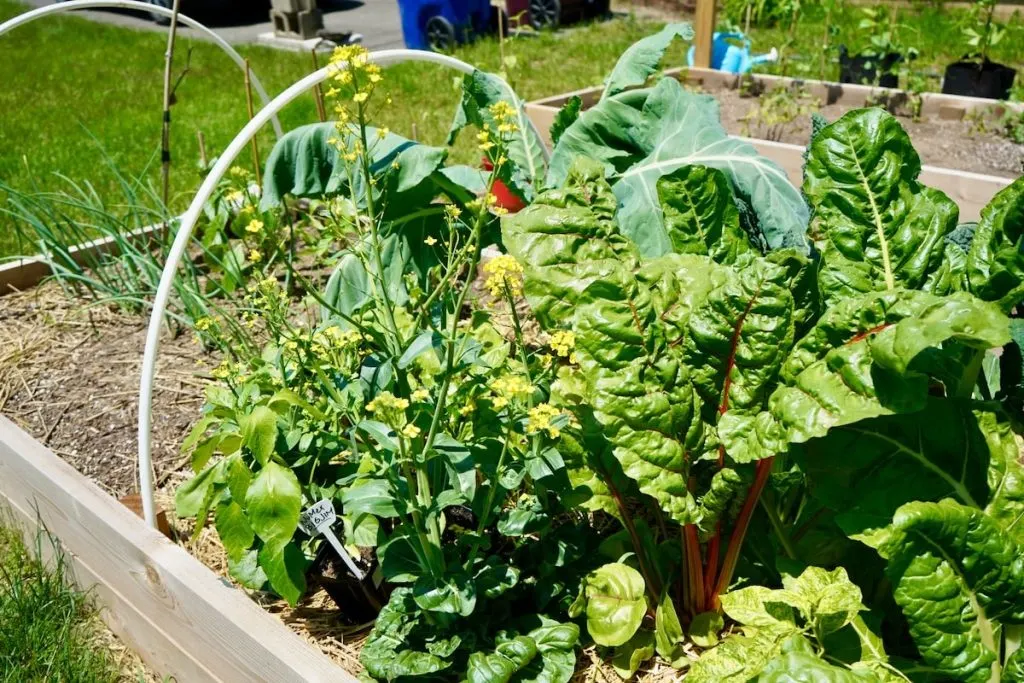
One of the most common mistakes that beginner gardeners make is neglecting proper soil preparation. Good soil preparation is crucial for the success of your vegetable garden, as it provides the necessary nutrients and a healthy environment for plant growth.
Here are some common mistakes to avoid when it comes to soil preparation:
- Not testing the soil: Before planting your vegetables, it’s important to test the soil to determine its pH level and nutrient content. This will help you understand what adjustments need to be made to ensure optimal growing conditions.
- Skipping soil amendments: Adding organic matter, such as compost or aged manure, can greatly improve the overall quality of your soil. These amendments increase nutrient levels, improve drainage, and promote beneficial microbial activity.
- Ignoring soil structure: The texture and structure of your soil are important factors to consider. Sandy soil drains quickly but lacks nutrients, while clay soil retains too much water and can become compacted. Amending the soil with organic matter can help improve its structure.
- Not removing weeds: Weeds can compete with your vegetable plants for nutrients, water, and sunlight. It’s essential to remove weeds from your garden bed before planting to prevent them from taking over and robbing your vegetables of essential resources.
- Overlooking soil moisture: Proper soil moisture is crucial for seed germination and plant growth. Make sure your soil is consistently moist but not waterlogged. Adding mulch to the soil surface can help retain moisture and prevent weed growth.
- Forgetting about soil pH: Different vegetables have different pH preferences. Some prefer acidic soil, while others thrive in alkaline soil. Adjusting the soil pH can help ensure that your vegetables receive the optimal nutrient absorption. Research the pH preferences of your vegetable plants and adjust accordingly.
By avoiding these common mistakes and properly preparing your soil, you will provide a strong foundation for your vegetable garden, leading to healthier plants and a bountiful harvest.
Overwatering or Underwatering
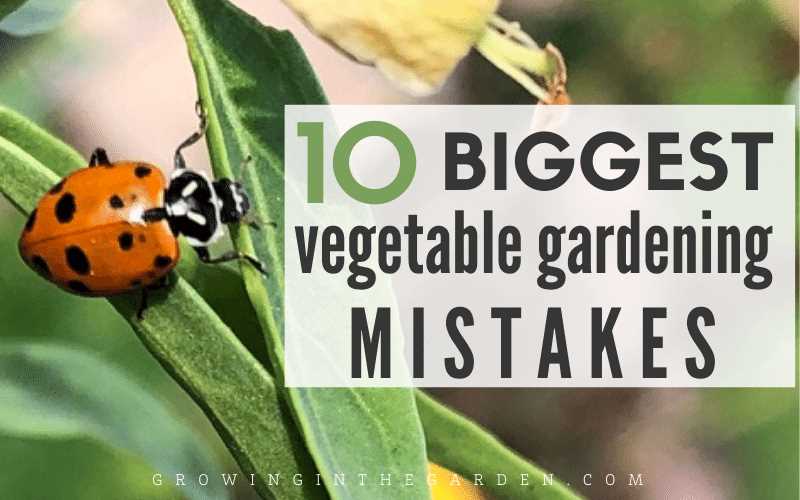
One of the most common mistakes that gardeners make when growing vegetables is overwatering or underwatering their plants. Both of these practices can have negative effects on the health and productivity of your vegetable garden.
Overwatering
Overwatering occurs when plants receive more water than they need. This can lead to the roots becoming waterlogged and deprived of oxygen, which can cause root rot and other diseases. Overwatered plants may also have yellowing leaves, stunted growth, and a weakened immune system, making them more susceptible to pests and diseases.
To avoid overwatering, it’s essential to only water your vegetables when they need it. Use a moisture meter or check the soil by sticking your finger about an inch into the ground. If the soil feels dry at that depth, it’s time to water. Additionally, make sure your pots or containers have drainage holes to allow excess water to escape.
Underwatering
On the other hand, underwatering occurs when plants do not receive enough water. This can cause wilting, yellowing leaves, and a decrease in overall productivity. Underwatered plants are also more vulnerable to pests and diseases due to their weakened state.
To prevent underwatering, make sure you water your vegetables deeply and thoroughly when needed. This means ensuring that the water reaches the roots and penetrates the entire root zone. Mulching can also help conserve moisture in the soil and reduce the frequency of watering.
The right balance
It’s important to find the right balance between overwatering and underwatering to keep your vegetables healthy and productive. Factors such as the type of vegetable, weather conditions, and soil type can influence their water needs.
Regularly monitoring the moisture levels of your soil and adjusting your watering practices accordingly will help you maintain the optimal watering schedule for your vegetables. Remember that it’s better to underwater than overwater, as plants are more adaptable to periods of drought than to excess moisture.
By avoiding the common mistake of overwatering or underwatering, you can help your vegetable garden thrive and ensure a bountiful harvest.
Ignoring Crop Rotation
One common mistake that many vegetable gardeners make is ignoring crop rotation. Crop rotation is the practice of planting different types of crops in different locations in your garden each year. This helps to prevent the build-up of pests, diseases, and nutrient deficiencies in the soil.
When you plant the same vegetables in the same spot year after year, pests and diseases that attack those plants can build up in the soil. This can lead to poor yields and the need for more pesticides and fertilizers.
By rotating your crops, you can break this cycle and reduce the risk of pests and diseases. Different crops have different nutrient needs, so rotating crops can also help to maintain soil fertility.
There are different methods of crop rotation, but a basic four-year rotation plan is often used. This involves dividing your garden into four sections and planting different groups of crops in each section each year.
Benefits of Crop Rotation:
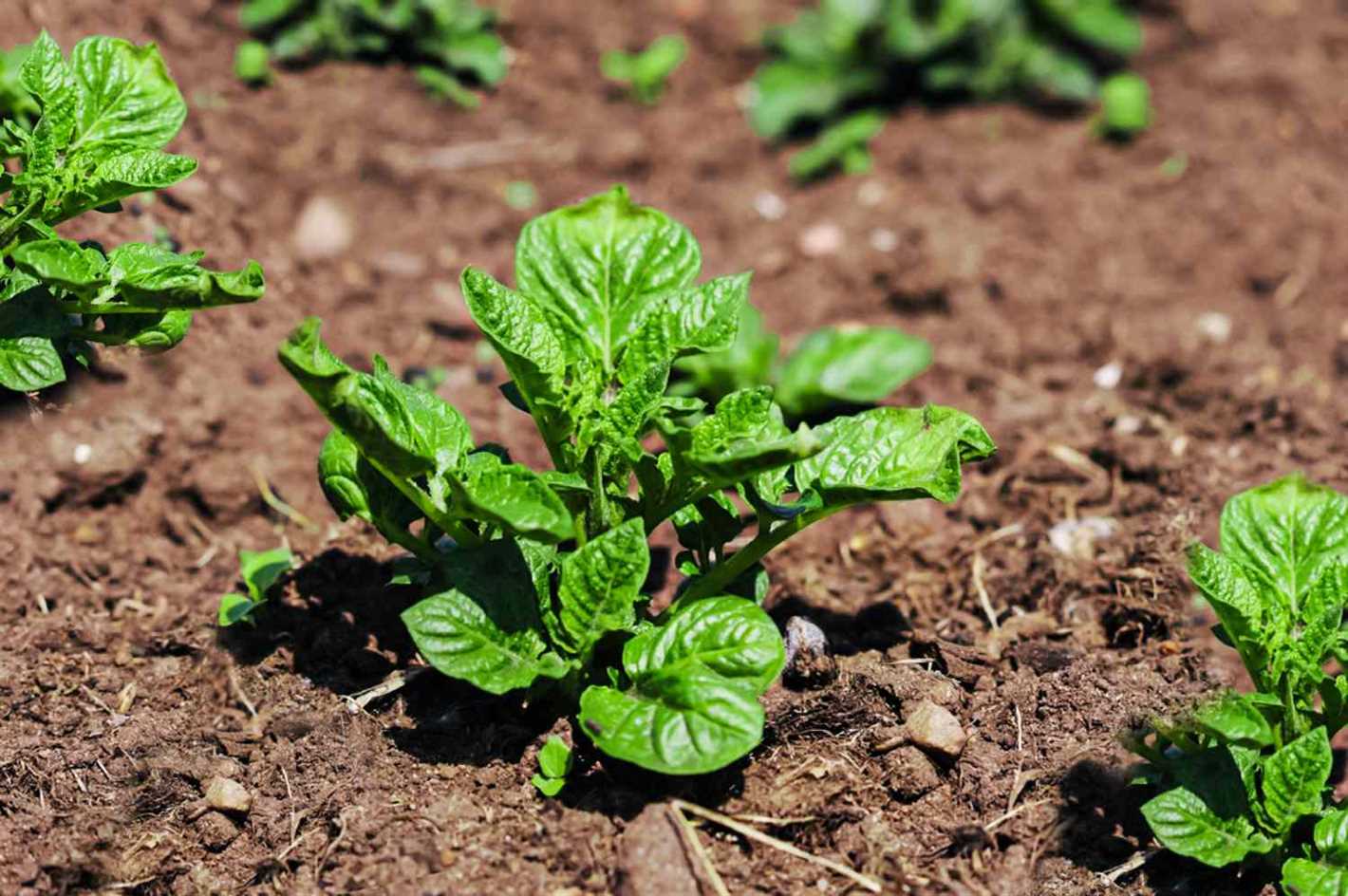
- Reduced pests and diseases
- Improved soil fertility
- Higher yields
- Reduced need for pesticides and fertilizers
Tips for Crop Rotation:
- Keep a record of what you plant each year and where
- Rotate crops from different plant families
- Include cover crops in your rotation plan
- Consider the nutrient needs of your crops
- Plan your rotation based on the size and layout of your garden
Conclusion
Ignoring crop rotation is a common mistake that can lead to poor yields and increased pest and disease problems in your vegetable garden. By practicing crop rotation and following some simple tips, you can improve soil fertility, reduce pests and diseases, and have a more successful vegetable garden.
Planting Too Close Together
A common mistake made by gardeners is planting vegetables too close together. While it may be tempting to maximize space and try to fit as many plants as possible in a small area, overcrowding can actually harm your plants.
When plants are too close together, they compete for resources like sunlight, water, and nutrients. This can lead to stunted growth, weak plants, and lower yields. It also creates ideal conditions for the spread of diseases and pests.
Spacing Recommendations:
- Follow the spacing recommendations on seed packets or plant labels. These guidelines are designed to ensure optimal growth and productivity.
- Give plants enough space to grow and spread their roots. This will allow them to access necessary nutrients and water.
- Adequate spacing also promotes air circulation, which helps prevent the development of fungal diseases.
Considerations for Vertical Gardening:
If you are growing vegetables vertically, such as using trellises or stakes, make sure to provide enough space for the plants to climb or spread out. This will prevent overcrowding and ensure that all plants receive sufficient sunlight and airflow.
Benefits of Proper Spacing:
By giving your vegetables enough room to grow, you can expect the following benefits:
- Healthy plants with adequate access to resources.
- Higher yields and larger, healthier vegetables.
- Reduced risk of disease and pest infestations.
- Easier maintenance and harvesting.
Conclusion:
Proper spacing is crucial for the success of your vegetable garden. Take the time to plan and follow spacing recommendations to ensure optimal growth, health, and productivity of your plants.
Failing to Provide Proper Support
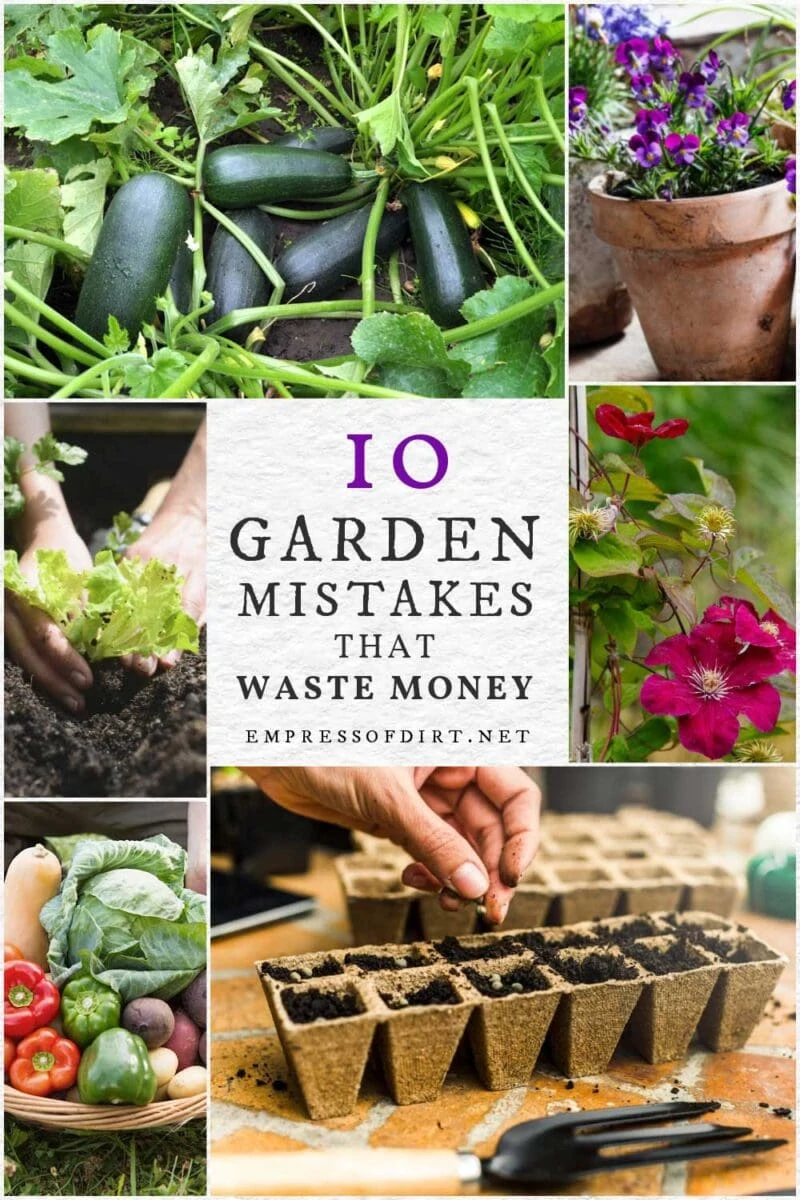
One common mistake that many vegetable gardeners make is failing to provide proper support for their plants. Without adequate support, plants can become tangled, floppy, or even break under the weight of their own foliage or fruit. To avoid this mistake, consider the following:
1. Staking
Some vegetables, such as tomatoes or peppers, require staking to keep them upright. Use stakes made of bamboo, wood, or metal, and drive them into the ground near the plants. Gently tie the plants to the stakes as they grow, using soft ties or twine.
2. Trellising
For vining vegetables like cucumbers or beans, trellising is a great way to provide support. Install a trellis or a fence panel structure that the plants can climb on. As the vines grow, guide them along the trellis and secure them with gentle ties.
3. Cage structures
Some plants, such as indeterminate tomatoes, benefit from being grown inside cages. These cages provide 360-degree support for the plants, allowing them to grow upright and preventing them from sprawling. Place the cage around the plant at the time of planting.
4. Netting
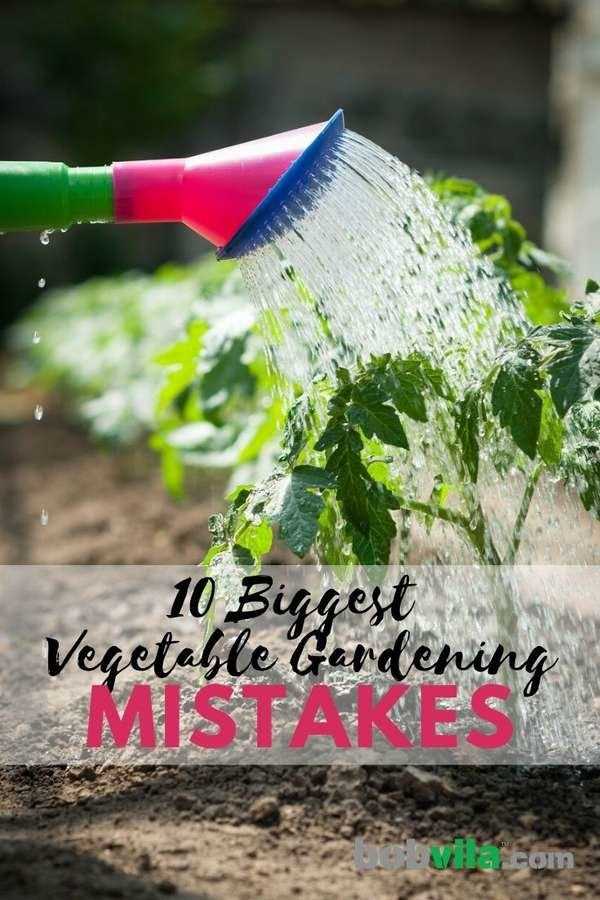
For plants that have fragile stems or require support throughout their growth, consider using netting. Install a vertical netting structure behind the plants and gently guide the stems through the holes as they grow. This will help keep the plants upright and prevent breakage.
5. Modular systems
If you are growing multiple plants of the same type, consider using a modular support system. These systems allow you to connect individual cages or stakes together, creating a larger support structure that can accommodate multiple plants in a row.
By providing proper support for your vegetable plants, you can ensure their health and productivity. Take the time to assess the needs of each type of plant you are growing and implement the appropriate support system to avoid common growth mistakes.
Not Pruning or Thinning Plants
One common mistake that many vegetable gardeners make is failing to prune or thin their plants. Pruning and thinning plants are important tasks that help promote healthier growth and higher yields. Here are some reasons why pruning and thinning are essential:
1. Enhanced air circulation
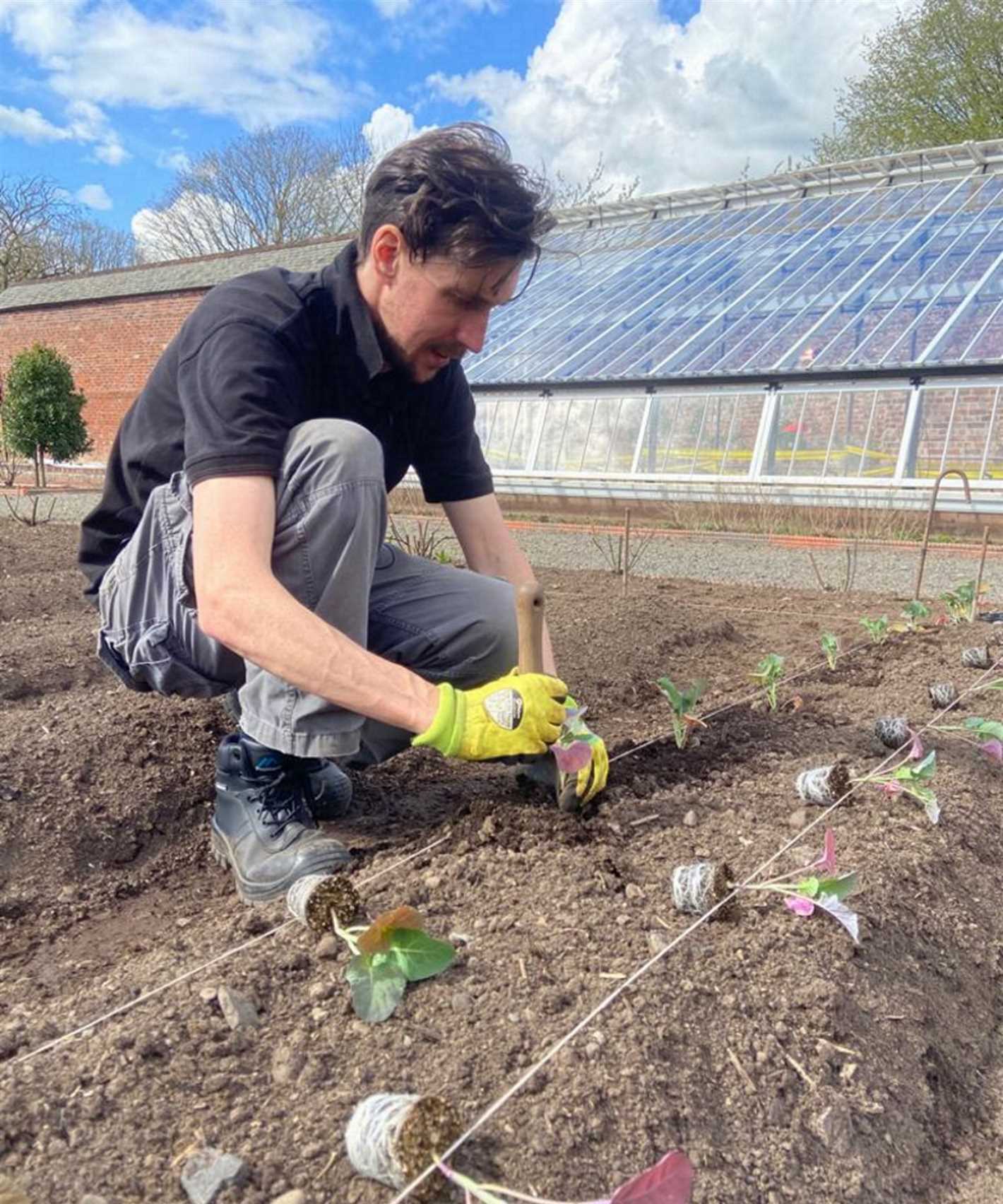
By pruning and thinning your plants, you provide better air circulation, which reduces the risk of fungal diseases. When the plants are too crowded, they can become a breeding ground for pathogens, leading to a decline in plant health.
2. Improved sunlight penetration
Thinning plants allows more sunlight to reach the remaining leaves and fruit. Sunlight is crucial for photosynthesis, a process that helps plants produce energy for growth and fruit development. Without adequate sunlight, your plants may produce less and smaller fruits.
3. Preventing competition for nutrients
When plants are overcrowded, they compete for nutrients in the soil. Thinning plants helps ensure that each plant has enough space and access to essential nutrients, resulting in healthier and more vigorous growth.
4. Minimizing pest problems
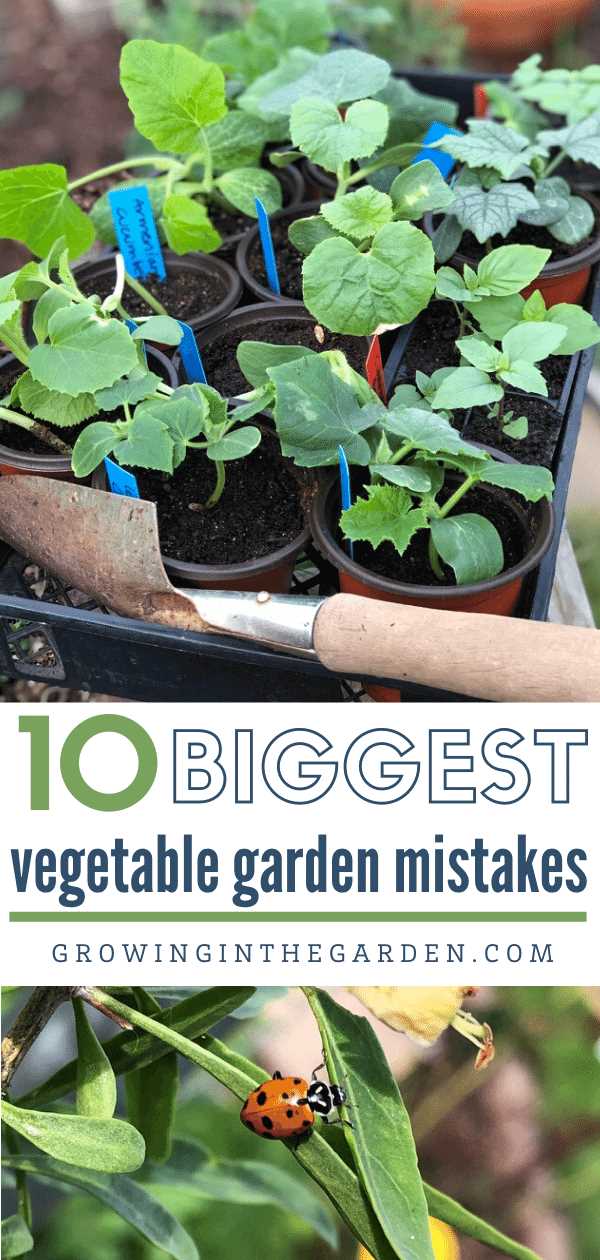
Densely planted vegetables can attract pests more easily. Pruning and thinning your plants create a more open and less appealing environment for pests. Additionally, when plants are spaced out, it becomes easier to spot and remove any pest infestations before they spread.
To prune your plants, remove any dead, damaged, or diseased leaves and branches. You should also prune excessive growth to maintain a desired shape or size. Thinning plants involves removing weaker or excess plants to create proper spacing between them.
Remember to avoid over-pruning or thinning, as it can stress the plants and hinder their growth. Understanding the specific needs of each vegetable variety is important, as different plants have different pruning requirements.
Ignoring Pest and Disease Management
Pest and disease management is a crucial aspect of growing vegetables. Ignoring this can lead to significant damage to your crops and reduce your overall harvest. It’s important to be proactive and take measures to prevent and control pests and diseases in your garden.
Common mistakes to avoid:
- Not identifying pests and diseases: Ignoring signs of pests and diseases can lead to the rapid spread of the problem. Take the time to familiarize yourself with common pests and diseases that affect vegetables, and regularly inspect your plants for any signs of infestation.
- Not practicing good garden hygiene: Poor garden hygiene can attract pests and diseases. Remove any fallen leaves or debris from the garden bed, as they can harbor pests and diseases. Keep the garden clean and tidy to minimize the risk of infestation.
- Not using protective measures: Using protective measures such as row covers, netting, or fences can help prevent pests from reaching your crops. These measures can be especially effective for protecting against common pests like insects, birds, and rodents.
- Not practicing crop rotation: Planting the same vegetables in the same location year after year can lead to a buildup of pests and diseases in the soil. Practice crop rotation by changing the location of your vegetable beds each year to disrupt pest and disease cycles.
- Not using organic pest control methods: Avoiding chemical pesticides and opting for organic pest control methods can help protect your vegetables and maintain a healthy garden ecosystem. Use natural pest control methods such as companion planting, beneficial insects, and organic pest repellents.
- Not monitoring and taking action: Regularly monitor your plants for signs of damage or infestation. When you identify a pest or disease problem, take immediate action to control it. Delaying treatment can allow the problem to worsen and potentially spread to other plants.
- Not researching plant diseases: Different vegetables are susceptible to different diseases. Research the common diseases that affect the types of vegetables you’re growing and take preventive measures to avoid these diseases.
By avoiding these common mistakes and implementing proper pest and disease management techniques, you can ensure a successful vegetable garden with healthy and productive crops.
Skipping Regular Weeding
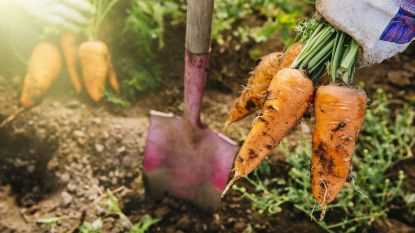
When growing vegetables, one common mistake that many gardeners make is skipping regular weeding. Weeding is an essential task that helps to keep the vegetable garden healthy and free from competing plants.
Why is weeding important?
Weeds can quickly take over your vegetable garden if left unchecked. They compete with your vegetables for essential nutrients, sunlight, and water, which can negatively impact their growth and yield. Weeds also provide shelter for pests and diseases, increasing the chances of your plants getting damaged or infected.
The consequences of skipping regular weeding
- Reduced vegetable growth: Weeds can steal nutrients and water from your vegetables, stunting their growth and reducing their overall productivity.
- Increased pest and disease problems: Weeds create a favorable environment for pests and diseases. Skipping weeding can lead to a higher pest infestation and increase the risk of disease transmission to your vegetable plants.
- Difficulty in harvesting: Large, mature weeds can make it difficult to locate and harvest your vegetables. They can hide the produce and make the process more time-consuming.
- Seed contamination: Some weeds produce seeds that can contaminate your garden soil, leading to future weed problems. Regular weeding helps prevent the spread of these weed seeds.
Tips for successful weeding
To avoid the mistake of skipping regular weeding, consider the following tips:
- Allocate a specific time for weeding each week. Make it a part of your gardening routine.
- Use appropriate weeding tools such as a hoe, hand fork, or weed puller to make the task easier and systematic.
- Weed after rainfall or watering when the soil is moist. Weeds are easier to remove when the soil is damp.
- Ensure you remove weeds with their roots intact to prevent regrowth.
- Consider mulching your vegetable garden to suppress future weed growth. Mulch acts as a protective layer, preventing weed seeds from germinating.
Conclusion
Regular weeding is crucial for maintaining a healthy vegetable garden. By dedicating time to remove weeds regularly, you can prevent competition for resources, reduce pest and disease problems, and promote better growth and yield from your vegetables.
Harvesting Too Late or Too Early
Harvesting vegetables at the right time is crucial to ensure optimal flavor, texture, and nutritional value. However, many gardeners make the mistake of harvesting their vegetables either too late or too early. Here are some common mistakes to avoid when it comes to harvesting:
- Not familiarizing yourself with the recommended harvest time for each vegetable. Different vegetables have different maturity timelines, so it’s important to do research or refer to seed packets for guidance.
- Waiting too long to harvest. Some vegetables, like zucchini or cucumbers, can become tough and tasteless if left on the plant for too long. Harvesting these types of vegetables when they are still young and tender is key.
- Harvesting too early. On the other hand, some vegetables need enough time to fully develop before they can be harvested. For example, tomatoes should be allowed to ripen on the vine until they reach their desired color and firmness.
- Ignoring the signs of readiness. Each vegetable has its own indicators of ripeness, such as color, size, or texture. Overlooking these signs can lead to harvesting at the wrong time.
- Not checking regularly. Make it a habit to check your plants daily for signs of readiness. Some vegetables can ripen quickly, so a missed day of checking can result in overripe produce.
- Harvesting during unfavorable weather conditions. Avoid harvesting vegetables during extremely hot or wet conditions, as this can impact their quality and shelf life.
- Using improper harvesting tools. Using the wrong tools or techniques can damage the plants and reduce yields. Invest in good quality tools and learn the proper techniques for each vegetable.
- Harvesting everything at once. Some vegetables, like leafy greens, can be harvested continuously by picking only a few leaves at a time. This allows the plants to continue growing and producing.
- Not storing harvested vegetables properly. Proper storage is crucial to maintain the freshness and quality of harvested vegetables. Follow the recommended storage guidelines for each vegetable to prolong their shelf life.
- Not adjusting your harvesting techniques based on the specific variety. Different varieties of the same vegetable may have different optimal harvest times. Take note of these variations and adjust your harvesting schedule accordingly.
Avoiding these mistakes and ensuring proper timing for harvesting will result in vegetables that are at their best in terms of flavor, texture, and overall quality.
“Question-Answer”
What are some common mistakes to avoid when growing vegetables?
Some common mistakes to avoid when growing vegetables include overwatering, planting vegetables too close together, not providing enough sunlight, not properly preparing the soil, and not controlling pests.
How often should I water my vegetable plants?
The frequency of watering vegetable plants depends on several factors such as the type of vegetable, the weather conditions, and the soil moisture level. As a general rule, vegetable plants usually require about 1-2 inches of water per week. However, it is important to monitor the soil moisture and adjust the watering schedule accordingly.
What are the consequences of overwatering vegetables?
Overwatering vegetables can lead to a number of issues such as root rot, fungus growth, nutrient leaching, and stunted growth. It deprives the plants of oxygen and can drown the roots, inhibiting their ability to take up essential nutrients.
How far apart should I plant my vegetable seeds?
The spacing between vegetable seeds depends on the specific type of vegetable. Different vegetables have different requirements for growth and development. Some vegetables, like carrots and lettuce, require thin spacing, while others, like tomatoes and peppers, require more space. It is important to follow the recommended spacing guidelines on the seed packet or consult a gardening guide for specific instructions.
Can I grow vegetables without direct sunlight?
While some vegetables can tolerate partial shade, most vegetable plants require at least 6 hours of direct sunlight per day to thrive. Without enough sunlight, the plants may become leggy, produce fewer fruits or vegetables, and have overall poor growth. If you don’t have access to direct sunlight, you can consider growing vegetables in containers or raised beds that can be moved to sunnier locations.
Should I use fertilizer when growing vegetables?
Using fertilizer when growing vegetables can help provide essential nutrients to the plants, leading to healthier growth and higher crop yields. However, it is important to use the right type and amount of fertilizer for the specific vegetables being grown. Too much fertilizer can burn the plants, while too little can result in nutrient deficiencies. It is recommended to conduct a soil test to determine the nutrient needs of the plants and follow the fertilizer application guidelines accordingly.
How can I protect my vegetable plants from pests?
There are several methods to protect vegetable plants from pests. Some common strategies include using physical barriers like fences or row covers, practicing crop rotation to disrupt pest life cycles, attracting beneficial insects and birds to the garden, using organic insecticides or neem oil, and regularly inspecting the plants for signs of pest damage. It is important to identify the specific pests affecting the vegetable plants and choose appropriate control methods.







